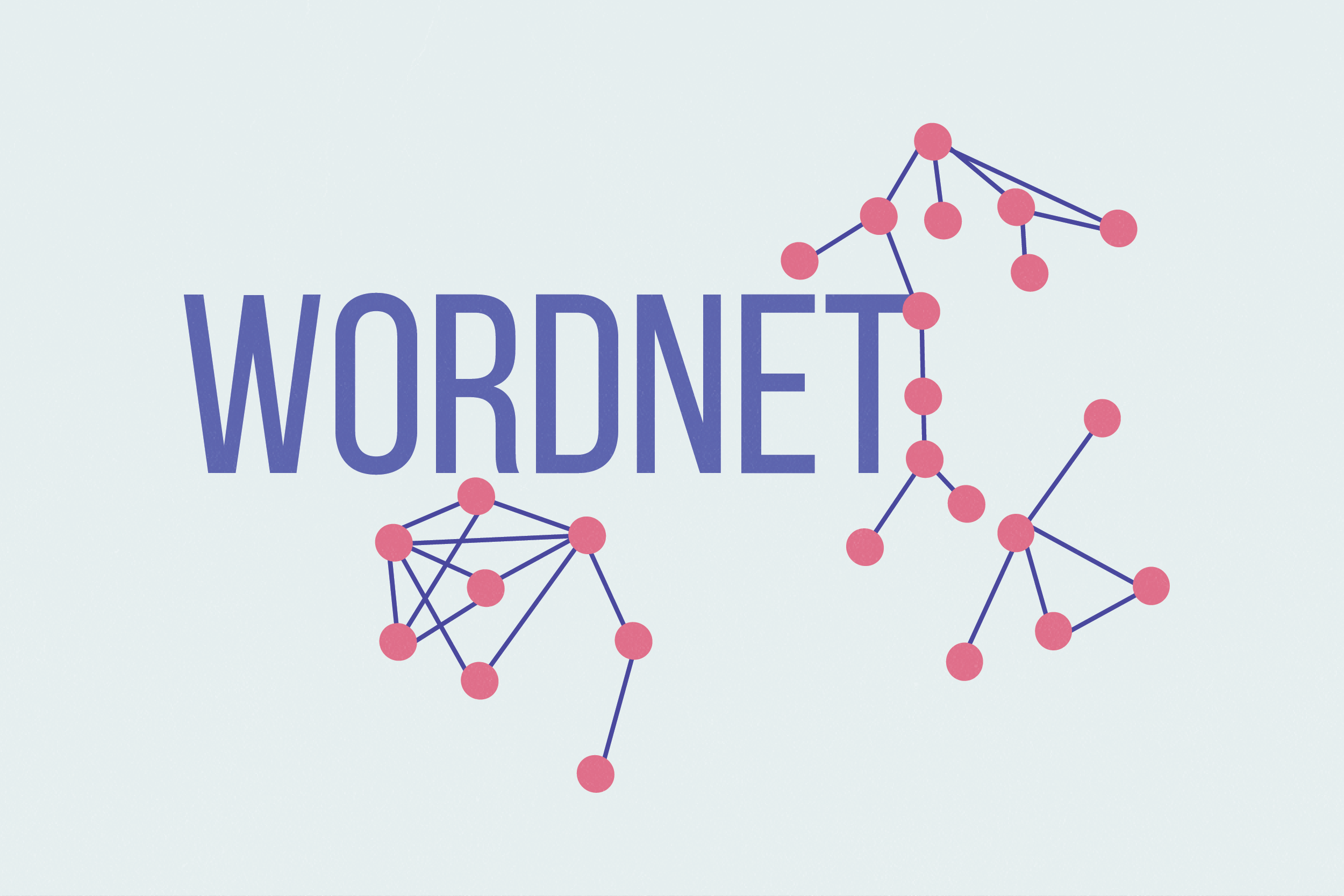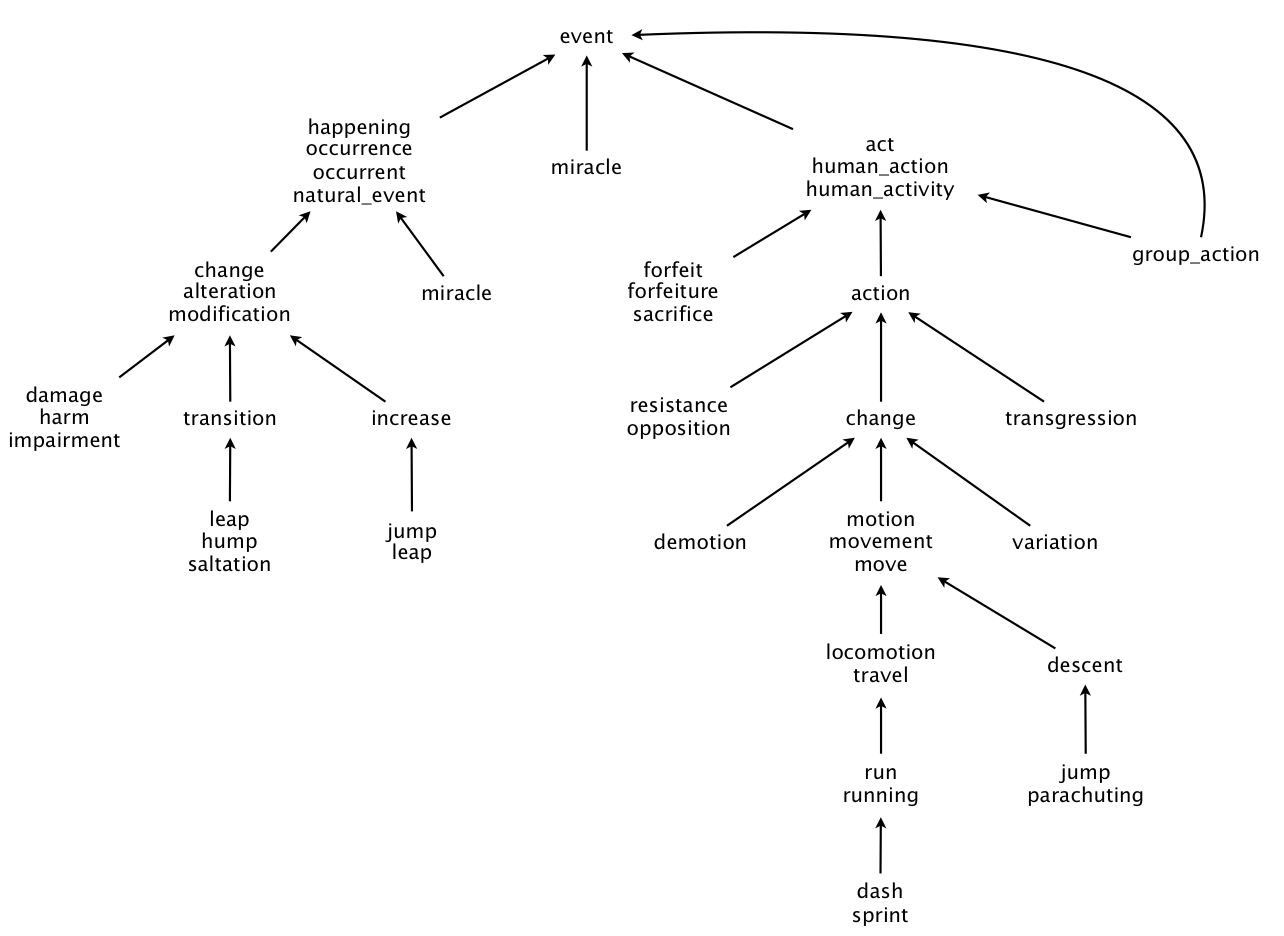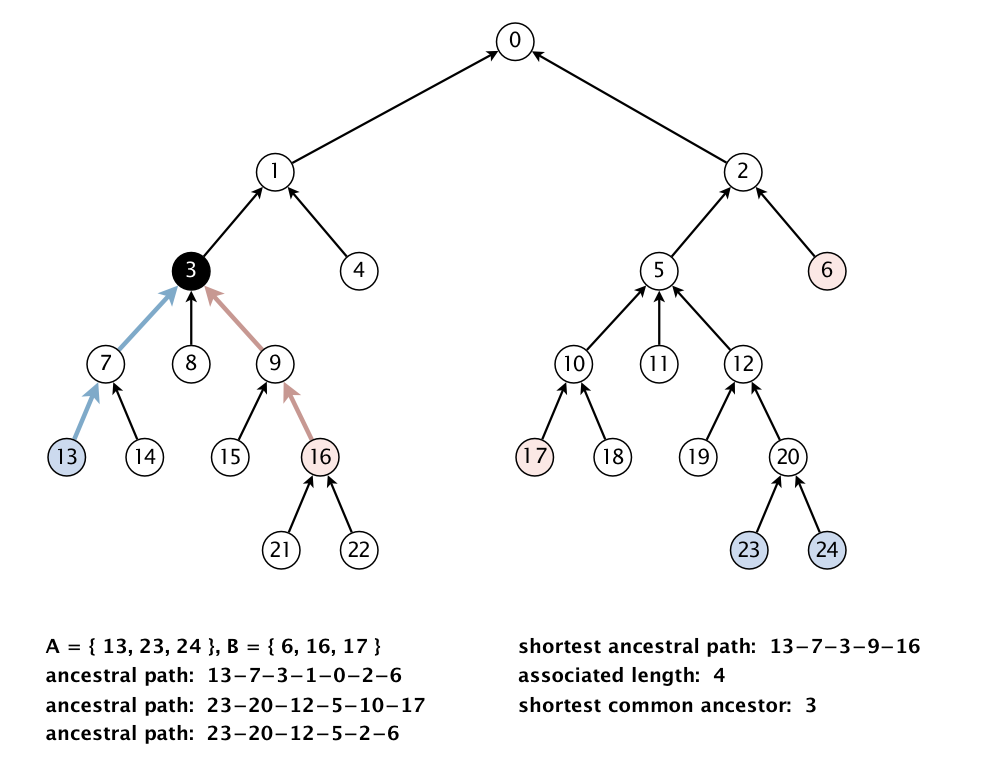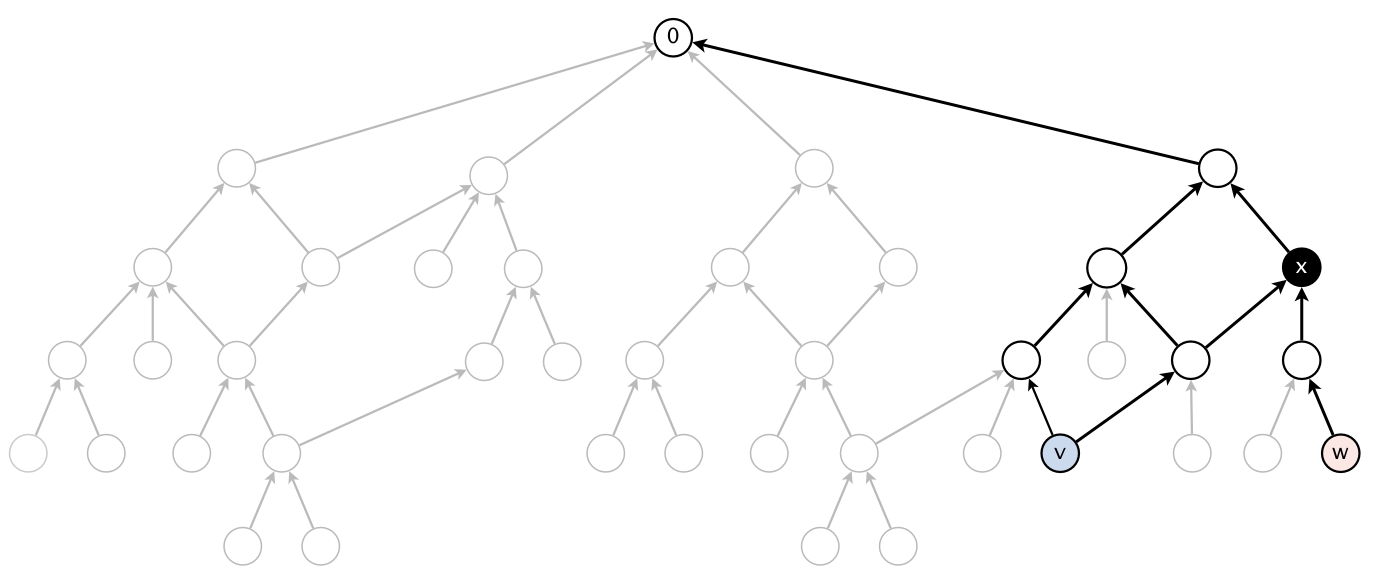 WordNet
WordNet
The WordNet digraph. Your first task is to build the WordNet digraph: each vertex v is an integer that represents a synset, and each directed edge v→w represents that w is a hypernym of v. The WordNet digraph is a rooted DAG: it is acyclic and has one vertex—the root—that is an ancestor of every other vertex. However, it is not necessarily a tree because a synset can have more than one hypernym. Here is a small subgraph of the WordNet digraph:

The WordNet input file formats. We now describe the two data files that you will use to create the WordNet digraph. The files are in comma-separated values (CSV) format: each line contains a sequence of fields, separated by commas.

AND_circuit, AND_gate }
has an id number of 36 and its gloss is
a circuit in a computer that fires only when all of its inputs fire.
The individual nouns that constitute a synset are separated by spaces.
If a noun contains more than one word, the underscore character connects
the words (and not the space character).

AND_circuit AND_Gate)
has 43273 (gate logic_gate) as its only hypernym. Line 34 means that
synset 34 (AIDS acquired_immune_deficiency_syndrome) has two hypernyms:
48504 (immunodeficiency) and 49019 (infectious_disease).
WordNet data type.
Implement an immutable data type WordNet with the following API:
public class WordNet {
// constructor takes the name of the two input files
public WordNet(String synsets, String hypernyms)
// the set of all WordNet nouns
public Iterable<String> nouns()
// is the word a WordNet noun?
public boolean isNoun(String word)
// a synset (second field of synsets.txt) that is a shortest common ancestor
// of noun1 and noun2 (defined below)
public String sca(String noun1, String noun2)
// distance between noun1 and noun2 (defined below)
public int distance(String noun1, String noun2)
// unit testing (required)
public static void main(String[] args)
}
Corner cases.
Throw an IllegalArgumentException in the following situations:
null
distance() or sca()
is not a WordNet noun.
Unit testing.
Your main() method must call each public constructor and method directly and
help verify that they work as prescribed (e.g., by printing results to standard output).
Performance requirements. Your implementation must achieve the following performance requirements. In the requirements below, assume that the number of characters in a noun or synset is bounded by a constant.
isNoun() must run in time logarithmic (or better) in
the number of nouns.
distance() and sca() must make exactly one call
to the lengthSubset() and ancestorSubset() methods in ShortestCommonAncestor,
respectively.
Shortest common ancestor. An ancestral path between two vertices v and w in a rooted DAG is a directed path from v to a common ancestor x, together with a directed path from w to the same ancestor x. A shortest ancestral path is an ancestral path of minimum total length. We refer to the common ancestor in a shortest ancestral path as a shortest common ancestor. Note that a shortest common ancestor always exists because the root is an ancestor of every vertex. Note also that an ancestral path is a path, but not a directed path.

We generalize the notion of shortest common ancestor to subsets of vertices. A shortest ancestral path of two subsets of vertices A and B is a shortest ancestral path among all pairs of vertices v and w, with v in A and w in B. As an example, the following figure (digraph25.txt) identifies several (but not all) ancestral paths between the red and blue vertices, including the shortest one.

Shortest common ancestor data type.
Implement an immutable data type ShortestCommonAncestor with the following API:
public class ShortestCommonAncestor {
// constructor takes a rooted DAG as argument
public ShortestCommonAncestor(Digraph G)
// length of shortest ancestral path between v and w
public int length(int v, int w)
// a shortest common ancestor of vertices v and w
public int ancestor(int v, int w)
// length of shortest ancestral path of vertex subsets A and B
public int lengthSubset(Iterable<Integer> subsetA, Iterable<Integer> subsetB)
// a shortest common ancestor of vertex subsets A and B
public int ancestorSubset(Iterable<Integer> subsetA, Iterable<Integer> subsetB)
// unit testing (required)
public static void main(String[] args)
}
Corner cases.
Throw an IllegalArgumentException in the following situations:
null
null item
Unit testing.
Your main() method must call each public constructor and method directly and
help verify that they work as prescribed (e.g., by printing results to standard output).
Basic performance requirements. Your implementation must achieve the following worst-case performance requirements, where E and V are the number of edges and vertices in the digraph, respectively.
Additional performance requirements (for extra credit).
In addition, the methods
length(), lengthSubset(), ancestor(), and
ancestorSubset() must take time proportional to
the number of vertices and edges reachable from the argument vertices (or better),
For example, to compute the shortest common ancestor of v and w
in the following digraph, your algorithm can examine only the highlighted vertices and edges;
it cannot initialize any vertex-indexed arrays.

Test client. The following test client takes the name of a digraph input file as as a command-line argument; creates the digraph; reads vertex pairs from standard input; and prints the length of the shortest ancestral path between the two vertices, along with a shortest common ancestor:
public static void main(String[] args) {
In in = new In(args[0]);
Digraph G = new Digraph(in);
ShortestCommonAncestor sca = new ShortestCommonAncestor(G);
while (!StdIn.isEmpty()) {
int v = StdIn.readInt();
int w = StdIn.readInt();
int length = sca.length(v, w);
int ancestor = sca.ancestor(v, w);
StdOut.printf("length = %d, ancestor = %d\n", length, ancestor);
}
}
Measuring the semantic relatedness of two nouns. Semantic relatedness refers to the degree to which two concepts are related. Measuring semantic relatedness is a challenging problem. For example, you consider George W. Bush and John F. Kennedy (two U.S. presidents) to be more closely related than George W. Bush and chimpanzee (two primates). It might not be clear whether George W. Bush and Eric Arthur Blair are more related than two arbitrary people. However, both George W. Bush and Eric Arthur Blair (a.k.a. George Orwell) are famous communicators and, therefore, closely related.
We define the semantic relatedness of two WordNet nouns x and y as follows:
- A = set of synsets in which x appears
- B = set of synsets in which y appears
- distance(x, y) = length of shortest ancestral path of subsets A and B
- sca(x, y) = a shortest common ancestor of subsets A and B
This is the notion of distance that you will use to implement the
distance()andsca()methods in theWordNetdata type.
Outcast detection. Given a list of WordNet nouns x1, x2, ..., xn, which noun is the least related to the others? To identify an outcast, compute the sum of the distances between each noun and every other one:
di = distance(xi, x1) + distance(xi, x2) + ... + distance(xi, xn)and return a noun xt for which dt is maximum. Note that distance(xi, xi) = 0, so it will not contribute to the sum.Implement an immutable data type
Outcastwith the following API:public class Outcast { // constructor takes a WordNet object public Outcast(WordNet wordnet) // given an array of WordNet nouns, return an outcast public String outcast(String[] nouns) // test client (see below) public static void main(String[] args) }Corner cases. Assume that the argument to
outcast()contains only valid WordNet nouns and that it contains at least two such nouns.Test client. The following test client takes from the command line the name of a synset file, the name of a hypernym file, followed by the names of outcast files, and prints an outcast in each file:
Here is a sample execution:public static void main(String[] args) { WordNet wordnet = new WordNet(args[0], args[1]); Outcast outcast = new Outcast(wordnet); for (int t = 2; t < args.length; t++) { In in = new In(args[t]); String[] nouns = in.readAllStrings(); StdOut.println(args[t] + ": " + outcast.outcast(nouns)); } }~/Desktop/wordnet> more outcast5.txt horse zebra cat bear table ~/Desktop/wordnet> more outcast8.txt water soda bed orange_juice milk apple_juice tea coffee ~/Desktop/wordnet> more outcast11.txt apple pear peach banana lime lemon blueberry strawberry mango watermelon potato ~/Desktop/wordnet> java-algs4 Outcast synsets.txt hypernyms.txt outcast5.txt outcast8.txt outcast11.txt outcast5.txt: table outcast8.txt: bed outcast11.txt: potatoAnalysis of running time. Analyze the potential effectiveness of your approach to this problem by answering the following questions:
Give your answers as a function of the number of vertices V and the number of edges E in the digraph.
- What is the order of growth of the worst-case running time of the
length(),lengthAncestor(),ancestor(), andancestorSubset()methods inShortestCommonAncestor?- What is the order of growth of the best-case running time of the
length(),lengthAncestor(),ancestor(), andancestorSubset()methods inShortestCommonAncestor?Deliverables. Submit
WordNet.java,ShortestCommonAncestor.java, andOutcast.java. Also submit any other supporting files (excluding those inalgs4.jar). You may not call any library functions other than those injava.lang,java.util, andalgs4.jar. Finally, submit readme.txt and acknowledgments.txt files and answer the questions.Grading.
file points WordNet.java14 ShortestCommonAncestor.java14 Outcast.java6 readme.txt6 40 Reminder: You can lose up to 4 points for breaking style principles and up to 2 points for inadequate unit testing.
Extra credit: You can earn 1–3 bonus points for meeting the additional performance requirements.
This assignment was created by Alina Ene and Kevin Wayne.
Copyright © 2006.